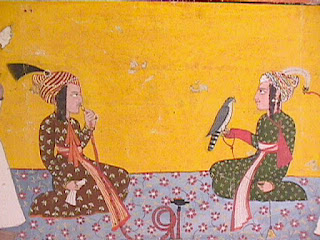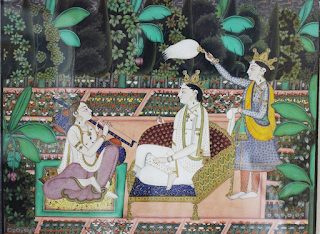Pahari Schools of Painting | Art in Himachal Pradesh | Kangra School, Basholi School, Arki School, Chamba School
Painting Styles of Himachal Pradesh
Pahari Schools of Painting:
Local schools of painting existed in Himachal Pradesh long before the intrusion of Mughal style. It is believed that 35 old styles flourished in Himachal Pradesh. These include Mandi Kalam, Kangra Kalam, Bilaspur Kalam, Arki Kalam, etc
Himachali paintings can be classified into three broad categories:
1.Miniature paintings drawn on stiff handmade paper.
2.Wall paintings from Chamba and Sultanpur Palace as well as National Museum in Delhi.
3.Manuscript paintings which flourished during the 18th and 19th centuries.
The Schools of Painting:
1.Basohli School
- This school is the oldest known school of painting in the hill area.
- It rose to its status Under Raja Kripal Pal (1678-94) of Basohli.
- The Basohli School used colours symbolically: red for love, yellow for spring and blue for the fertile rains and clouds.
- It spread to other hill states of Mankot, Nurpur, Kullu, Mandi, Suket, Bilaspur, Nalagarh, Chamba and Kangra.
- The Archaeological Survey of India report states that this school cant possibly be of Mughal origin and the so-called Tibeti pictures are nothing but late productions of the school.
2.Kangra School
- This is referred to as the second phase of Pahari School of painting.
- It started in Guler during the reign of Raja Govardhan Chand (1745-73).
- Kangra took over Guler and Raja Sansar Chand of Kangra patronised Kangra Kalam.
- The complete development of this school is said to have taken place at Sujanpur Tira.
- The central theme of Kangra paintings was Lord Krishna and his loved Radha.
- Focal theme is usually Shringhar or erotic sentiment.
- Despite having such religious representations, Kangra school was influenced by Mughal style.
- Kangra paintings have received geographical indicator which gives them a Unique Identity in the world market.
3.Arki School
- Basohli school of painting exercise influence over Arki School but later on Kangra style was adopted.
- During the rule of Raja Mehar Chand, Rana Boop Chand it was Basohli Kalam but under Raja Jagat Singh and Raja Shiv Sharan Singh Kangra Kalam flourished.
- The Arki school of painting was founded by Raja Subha Chand.
4.Chamba School
- Similar to the Arki school, the early Chamba paintings were influenced by Basholi School whereas later on Kangra School became prominent.
- Raja Udai Singh was the first one to give patronage to paintings.
- This school is famous for its miniature paintings.
- Usually Chamba paintings depict religious themes from the lives of Lord Rama and Lord Krishna.
- The most famous painters of Chamba paintings were Nikka and Ranjha.
- The Chamba paintings are known for their mastery in naturalism detailed artwork.






